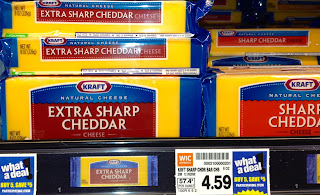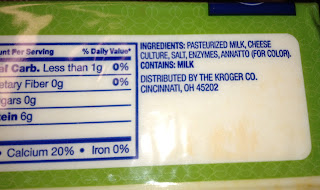This afternoon we went to Kroger to try to get the WIC items we couldn't get at Meijer yesterday. Kroger helpfully labels WIC-allowed items right on the shelf. But even that is a little confusing. Here are some of the cheeses we found:


These look like they are covered, for a person who has cheese on their approved monthly shopping list, but the WIC materials say that you can't buy cheese that costs more than $8.00 a pound. So we decided to avoid risking another mess at the checkout. This fresh mozarella met the price point and we considered it:

But we decided to see what was in the regular cheese section. There was Kraft:

But Kraft (and a lot of store brands) now have Natamycin in them. That's a relatively new thing:

I don't want to eat that. To me it's like buying bread that is pre-injected with penicillin. We really just don't need to _taunt_ our food into developing antibiotic-resistant pathogens like that. This store brand had an acceptable ingredient list, the price was under the cutoff point, and it was listed on the shelf as WIC-allowed:


Remember, yesterday, at Meijer, the Meijer store brand equivalent was rejected. But wait -- what's this? A store brand of Vermont cheddar actually made by Cabot? Yes, please. Cabot cheese is very good.

On to juice. This is the refrigerated juice section:

Supposedly WIC covers refrigerated juices -- but there was not one product in this entire section that they covered. So they should take that out of the brochure. It seems to be obsolete information.
They do cover some specific non-refrigerated bottled juices. Remember yesterday we tried to buy a V-8 juice that matched the printed criteria, but it arbitrarily wasn't approved? Well, for this reason it's really nice to have the stuff marked right on the shelf. Here are some of the approved juices:




But that grape juice? I'm reminded of a scene in the movie Men in Black when the alien "bug," wearing the dead farmer's skin, walks into his home and demands that his wife give him sugar. In water. Our kids would just pound that, and it's actually a bottle of tooth decay and metabolic syndrome and a lifetime of bad dietary choices. So, no thanks. The V8 and the pineapple juice -- acidic juices sold in metal cans? No thank you. I was surprised, honestly, to find out that those products even still existed. And the regular tomato juice? It has as much sodium as canned soup. However, we did find a low-sodium version, and took some home:

There was also a "spicy" version that wasn't low sodium, but which looked like it might actually make an good soup:

Our two-year-old in particular loves hot and spicy food. Seriously, he can't get enough chipotle chili powder and Sriracha sauce. If that gets him to eat a lot of vegetables, I'm not going to complain. So maybe we'll try blending this with some low-sodium organic chicken broth, some of our dried herbs and vegetables, and gluten-free rice pasta, and maybe some chicken. So we're going to try that. Come over some night and try it!
We also found some frozen concentrated orange juice that was WIC approved. I'm not going to upload pictures of that. Let's just say that we skipped the Minute Maid and went for the store brand with added calcium.
Yesterday we had to put back a bunch of canned black beans because they weren't a specifically approved brand. They were 99 cents a can, but these Busch canned beans at $1.39 a can are all covered, and all clearly marked:





So we bought eight cans of cannelini beans (those are effing delicious, by the way), and eight cans of black beans (our other favorite). Maybe next month we will mix it up with some kidneys and garbanzos (yes, the party never stops at the Potts house!) Dry beans like this are also covered:

But we usually get this kind -- locally grown -- and they are not approved for WIC:

But -- as you'll see below -- I think we're pretty well set for dry beans. I am not really sure what the best value is, in terms of cost per ounce of finished product. The sodium content of the canned beans is higher, since they have added salt, but it is not really a big deal to rinse them.
Finally, back to the goat's milk. Grace is supposedly, according to her documentation, allowed to buy up to 22 quarts per month of low-fat goat's milk. This was the only WIC-approved goat's milk at Kroger (and the only goat's milk, in the store, period):

Aaaand this item was rejected. Although it was not very clear. At Meijer, you run your WIC card through at the start of the order, and it will flag items that are not approved as you go. At Kroger, you just start scanning items, and at the end, pay with your WIC card. If there are non-approved items it just asks you for more money to cover them. This is quite confusing -- it is not obvious from the receipt which items weren't approved, so again we had to stand in line for some time with multiple checkout clerks trying to figure out what was wrong, and then we had to go to the service desk and try to figure it out there. (Hint: they don't know).
Grace tried to call the WIC office when we got back home, but it was after five at that point, so there was no one who could answer her question. I think the issue is that Grace is only approved to buy low-fat milk, and the goat's milk they had for sale at both Kroger and Meijer was counted as full-fat milk. Some folks are approved for full-fat milk. I'm not sure why she isn't -- she is both pregnant and breastfeeding. In any case, I'm not sure there are any stores in the area that carry a lowfat goat's milk. The WIC office might know, but if they don't, I guess we just have to start calling around.
So, there it is -- the WIC purchases are much easier to manage at Kroger, but there is still some confusion. We'll talk about this some more. The WIC office is holding a class -- people meet at, god help us, Wal-Mart. I think Grace is going to go just so we can get the official story on how it is supposed to work. Because, honestly, while I am really happy that we can get these supplemental food items, it is still far more confusing and difficult than it should be. It seems to me that so few specific foods are covered that, aside from produce, the WIC pamphlets shouldn't try to describe general characteristics of food items that are supposed to be approved -- for example, the Meijer cheese, the V-8 juice, etc. They should just show the exact items that are covered, with text descriptions and pictures. Items should be labeled on the shelves at Meijer. And all the participating stores ought to stock at least one item that fits each category. If "lowfat goat's milk" isn't for sale anywhere around here, well, being approved to get it for free is a pretty effing useless benefit to have.
People sometimes ask me how we're doing, with not having a job. I'm applying for a lot of jobs. Our savings are gradually decreasing, but we have medical coverage for everyone but me, our mortgage is paid for, for a while, and we are getting food assistance now, with more on the way. This is our basement food storage:

Over the past year or so, I've been gradually buying a little extra non-perishable food each month, and filling up the shelves. We've been filling up a chest freezer with meats, too. We are rotating older non-perishable items out and new ones in. On the left are dry beans and brown rice and nuts and unsweetened applesauce. In the middle are salad dressings, mayo, hot sauce, canned fish (tuna and salmon), and canned tomatoes of various types. On the right are things like boxes of chicken broth, canned beans, and canned refried beans. There's the rest of a fifty-pound bag of Michigan-grown pinto beans, the stuff that isn't in glass jars yet. Those are really good in chili too. We're slowly buying more glass jars (because we have the occasional mouse, and it is amazing what they will chew through).
The sixteen cans of beans we brought home today fit right in there. There's more in the pantry upstairs, but this is the bulk of it. It's part of our savings.




When our tax refund comes in, I'm going to use a chunk of it to buy some big-ticket items -- a couple of gallons of olive oil, a couple of gallons of grapeseed oil, and a few pounds of unrefined coconut oil. And we'll get the shelves filled up, so that we can buy, or have covered by food assistance, only perishable foods for a while, if we need to.
So how am I doing? I'm not feeling too bad. The economy may be in free-fall, my career may be basically at a dead end, we may have to leave our home. But at least one thing is taken care of, for the time being, and for a good while longer than that, actually -- we'll all be well-fed.


No comments:
Post a Comment